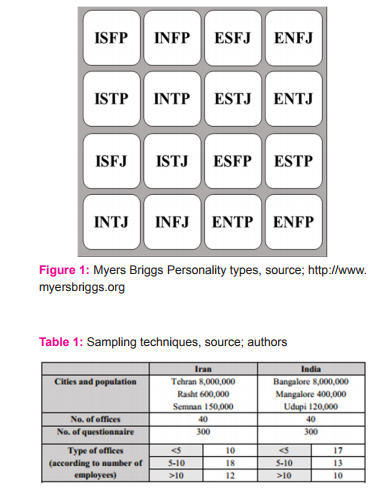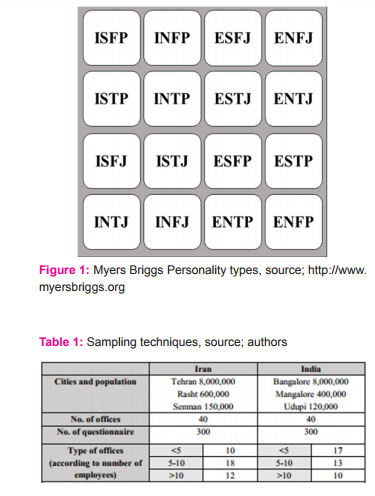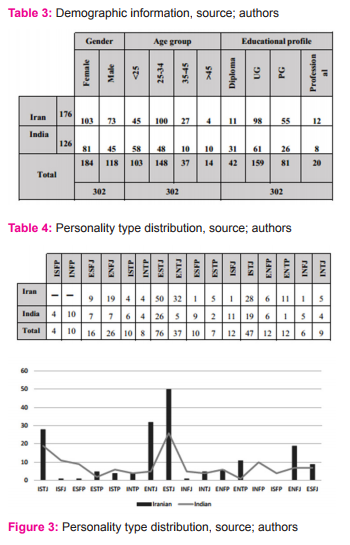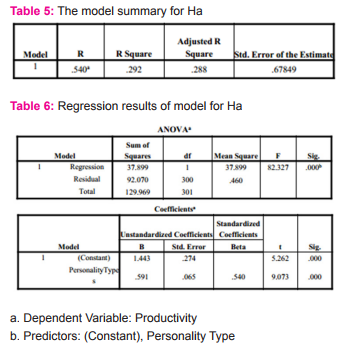IJCRR - 7(21), November, 2015
Pages: 53-58
Date of Publication: 11-Nov-2015
Print Article
Download XML Download PDF
EVALUATION OF MYERS-BRIGGS PERSONALITY TRAITS IN OFFICES AND ITS EFFECTS ON PRODUCTIVITY OF EMPLOYEES: AN EMPIRICAL STUDY
Author: Zahra Poursafar, Nandineni Rama Devi, Lewlyn L. R. Rodrigues
Category: Healthcare
Abstract:Background: Office design after physical requirement has a second concern which belongs to Psychology. The concept of Psychology and office spaces is a prominent issue for designers when planning stages of a redesign or a new workspace. Offices or workspaces today are an evolution of sorts affected by the truly diverse mixture of architectural and psychological elements which are working together in the same space. Aim: The focus of first part of this research is to identify the employee's Personality type in Architect's offices in two Asian countries; Iran and India. The second part of the study investigates the existing productivity of employees to identify the influence of Personality types. Methodology: The good-quality data has been collected from a well- designed questionnaire. The mode of the delivery was through the online questionnaire and hardy copy ones. Result: The findings of this study explore the dominant Personality type in Architect's offices and also reveal that productivity in an Architect's office interior is affected by employee's Personality types. Conclusions: Designers benefit from knowing occupant's Personality types. Since each Personality types have own characteristics, needs and desires, then outcome of the study could be used as a guideline for designer to have a more successful project. Differences between Personality types would have positive and negative effects on their Productivity. The results would help designers to improve the physical environment of office suits to occupant's wishes.
Keywords: Psychology, Personality types, Architect’s office, Productivity
Full Text:
INTRODUCTION
Architect’s office is an office which employs one or more architects and practices the profession of Architecture. The goal of these offices is to provide services (drawing, planning and consulting) in connection with the design and construction of buildings. The quality of the work environment in these offices requires the response to two issues:
• Managerial behavior and environmental condition
• User needs and their relationship to the environmental design
An important part of this environment is about “psychological implications of Architecture”. In Architectural Psychology can be described as a branch of environmental or ecological Psychology. This deals with the psychological processes of the interaction between man and his environment, as for example spatial perception, spatial thinking, orientation behavior, or spatial experience, territorial behavior, living requirements and satisfaction, local identity1 . It is not merely about the physical characteristics and features of buildings; it is about occupant’s perception and reaction to physical environment. This research, attempts to investigate and evaluate the distribution of Personality types in a comparison approach to enhance knowledge about work Psychology. The survey conducting to two populated country in Asia; Iran and India, to determine the dominant Personality type and find out the frequency of each type in Architect’s offices. According to different psychological characteristics of each type, environment can be designed to suit dominant user’s preferences, which will be more efficient in terms of cost and quality. The second part, studies the existing Productivity of employees in workplace to identify the influence or lack of influence of Personality types on employee’sProductivity in Architect’s office. ?
LITERATURE REVIEW
Workplace Psychology
Workplace design needs to be based on actual work practices and satisfy a range of human needs to inspire the most productive and innovative work outcomes2 . Davies (2005) argues that for a worker to be productive and committed, the reward structure and work itself, need to be aligned with their values. Workplace Psychology has a number of underpinning theories of motivation and commitment that to try to predict and influence worker behaviour and thus their Productivity3 .
Personality
Personality is one of the important concepts in Psychology. Sometimes Personality can be defined as noticeable psychological differences between individuals. Personality traits can be defined as dimensions of individual differences in tendencies to show consistent patterns of thoughts, feeling, and actions4 . Individual Personality traits such as extroversion and introversion can also influence a worker’s satisfaction with office layouts. Extroverts are more likely to be comfortable in open plan5 .Work situations with the likely increased number of interactions and their greater comfort with higher levels of arousal6 . This research is applying the MBTI theory to identify the employee’s Personality types. Myers-Briggs Type Indicator (MBTI) is a Personality theory that was developed by Isabel Briggs Myers and Katharine Briggs, and has been in use for over 60 years unlike many Personality theories, the MBTI is based on the assumption that people prefer a certain way of being7 . The history of the Myers-Briggs Type Indicator started with Carl Jung, the founder of analytical Psychology. Jung believed that people are either energized by the external world (Extraversion) or their own internal world (Introversion). He also observed that people took in information (Perceiving) or organized the information and came up with a conclusion (Judging). He noted that people generally engaged in one more than the other. Thus, in 1921, Jung published Psychological Types in which he presented the idea of Jungian archetypes7 . Isabel Myers believed in the beauty of human Personality. Myers wanted to develop an instrument that would reflect one’s preference not only for Introversion or Extraversion but for Perception and Judgment as well. With the onset of World War II, she developed the test to resolve conflicts and help people decide on appropriate careers. She believed that many problems involving human interaction and personal choices could be handled more successfully with Carl Jung’s theory of psychological types in mind. The Myers-Briggs Type Indicator, developed by Myers, and her mother Katharine C. Briggs, provides a structure for understanding both similarities and differences among human beings8 . The Myers- Briggs model of Personality is based on four preferences:
• E or I (Extraversion or Introversion)
• S or N (Sensing or intuition)
• T or F (Thinking or Feeling)
• J or P (Judgment or Perception)8
The 16 Personality types of the Myers-Briggs Type Indicator instrument are listed in
figure 1. Figure 1, Myers Briggs Personality types, source; http:// www.myersbriggs.org
Office Productivity
To achieve high levels of employee Productivity, organizations must ensure that the physical environment is conducive to organizational needs facilitating interaction and privacy, formality and informality, functionality and cross-disciplinarily. Consequently, the physical environment is a tool that can be leveraged both to improve business results9 . Employees are a company’s livelihood. How they feel about the work they are doing and the results received from that work directly impact an organization’s performance and, ultimately, its stability10. Employee’s morale and state of mind would have impacts on their performance in work area. Morale has a direct impact on the Productivity11.
METHODOLOGY
The primary data for the survey was collected from 302 employees. Initially 600 questionnaires were distributed randomly to the respondents in India and Iran. Table 1 explains the details of sampling techniques. Table 1, Sampling techniques, source; authors Totally out of many offices in town and cities in both countries, 80 offices in six cities were taken as sample (table 2). Table 2, Sample distribution details, source; authors The data which is collected through the survey is based on the workers’ self-awareness and honestly to answer the Personality test questions and opinions about the workplace. The objectives of the study include: • To determine the Personality types distribution in Architect’s offices, • To identify the dominant Personality type in Architect’s offices in two countries, • To investigate the effect of Personality types on employee’s Productivity. Survey results could bealtering if the survey would conduct to the other office’s employees, because of changing in dominant Personality types. Also, analysis could be extended by investigating the gender differences towards the effects of Personality on workplace environment. Thus, this research study explores the following research hypothesis; Ha ; Personality types in Architect’s offices has a significant influence on Productivity. In this connection, the relationship between Personality types and Productivity can be conceptualized and depicted in Figure 2. Figure 2, Conceptual Model
FINDINGS
Demographic Information
The first part of questionnaire dedicated to demographic data, collected from the 302 employees from both countries, as shown in table 3. Table 3, Demographic information, source; authors The questionnaires equally distributed in both the countries in case of numbers, but the return rate was different. Around 58% of Iranian and 42% of Indian respondents returned the questionnaire. The number of Iranian attendees in the survey is more, but overall result is coming in the form of the percentage to whole. According to the table3, most of the employees are Architect Offices are female in both the countries. Dominant age group for Iranian employees is 25-34 years old, but data indicates that Indian employees in Architect’s offices are younger (<25). This difference would results from higher number of employees with the diploma degree in Architect’s offices in India. India’s All India Council of Technical Education (AICTE) reported, in 2013, that there are more than 4,599 vocational institutions that offer degrees, diploma and post-diploma in Architecture, engineering and others. There were 1.74 million students enrolled in these schools. Total annual intake capacity for technical diplomas and degrees exceeded 3.4 million in 2012. Survey results in case of education level, most of the respondents in Architect’s offices have at least UG certificate in Architecture. But in Iran percentage of employees with master degree is more than India. Indian offices employs a higher percentage of architects with diploma in Architecture.
Personality Type Identification
Second part of the survey concerns with the standard questions of Myers-Briggs scale, identifying the Personality types of the employees. (thepersonalitypage.com) Personality type matters because it impacts everything, including personal, work and social life. Being aware of Personality type helps people to spend more time to understanding the dynamics of their Personality, to become more effective and efficient. This awareness has also some benefits at work. It gives the opportunity to match talent to job requirements, Make better decisions as a team, Conduct better meetings, and Improve communication since they understand others’ points of view. When type training is implemented in work groups, teams begin working better together within weeks, then the company becomes more productive. Table 4 and figure 3 illustrated the Personality type distribution and their frequency for 126 Indian and 176 Iranian respondents. Table 4, Personality type distribution, source; authors Figure 3, Personality type distribution, source; authors According to the result, there are some similarities and differences between two samples distributions. ESTJ is the most dominant Personality type in both the samples followed by ISTJ, then it would result that these types are the most populated Personality types in the architect’s cluster in these two countries. In Iranian group among 176 attendees, ESTJ, ISTJ, ENFJ and ENTJ are most populated types. Figure 4, Distribution of indicators in samples, source; authors Figure 4 shows Persian attendees have strong preferences of E, T and J. In connection to literature review; survey finding indicates that Persian architects are socialized, objective and have a tendency to organized life. In Indian sample, the number of preferences are nearly equal to each other, the distribution assumed to be approximately symmetrical.
Concerning respondent’s Productivity
Questions in this section, are asking about the physical and non-physical elements which have effects on employee’s Productivity- The word of Productivity, refer to the quantitative output of their job-. Questions are in two forms of Likert scale, and multiple choices answer. Important variables in these parts are work hours, taking break in working time, completion and incompletion of the assignments in working hours and the reasons of this incompletion. The result indicates that unpleasant physical environments along with the managerial problem and employee’s Personality types are the strongest elements which affect employee’s Productivity. In connection with the findings in this part, the hypothesis of the study is tested after a linear regression analysis. Table 5, the model summary for Ha R, the multiple correlation coefficient, is the linear correlation between the observed and model-predicted values of the dependent variable. Its large value (0.54) indicates a strong relationship. The coefficient of determination R. square = 0.292 (Table 29). This gives us the ratio of explained variation to total variation. On converting the R. square value to percentage it comes to be approximately 29 Percent. From this percentage it is concluded that 29 percent of the variability of employees’ Productivity is accounted for by the variables in this model. Table 6, Regression results of model for Ha The regression and residual sums of squares (Table 6) indicates that the variation in Ra is explained by the model to about 58%. The significance value of the F statistic is less than 0.05, which means that the variation explained by the model is not due to chance. Also, null hypothesis stands rejected. Then, Personality type has a significant influence on the Productivity. The Regression Equation: Employees Productivity= 1.443 + 0.591 Personality Types
CONCLUSION
Office interior design is a multi-dimensional study concern with the physical layout of space and psychological characteristics of users. User’s positive or negative reactions to the environment affected by their preferences and desires. Then employees’ physical and psychological demands should be clear to minimize the negative response in work area. The more the architect understands about user’s interacting with their environments, the better designs will come out. Understanding principles about employees’ Personality and the pattern of their behaviour will help architects to design with greater outcomes. The study demonstrates that employees have different interests and concerns in their work environment and these differences would have positive and negative effects on their Productivity. Thus the creation and preservation of an interior space is required to consider people Personality types and attempt to increase the sense of well -being by attention to their inner characteristics.
ACKNOWLEDGEMENT
Authors are thankful to all the principles architects of the organizations for giving permission to their employees for online and personal participation. The authors are also grateful to authors, editors and publishers of all those articles, journals and books from where the literature for this article has been reviewed and discussed.






References:
1. Oberascher, L. 2015. Available from: http://leoncolor.com.
2. Davies, H. The psychological and physical needs of workers impacting office design, in COBRA 2010: Proceedings of the RICS Foundation Construction and Building Research Conference, COBRA, London, England. 2010.
3. Davies, H. Productivity and the knowledge worker, QUT Research Week International Conference, Queensland University of Technology, Brisbane, Australia. 2005.
4. McCrae, RR, Costa, PT. Personality in adulthood: a five-factor theory perspective, New York, Guilford Press. 2003.
5. Vischer, J. The concept of workplace performance and its value to managers California Management Review. 2006; 49(2): 1-18.
6. Oseland, N. The impact of psychological needs on office design, Journal of Corporate Real Estate, 2009; 11(4): 244-254.
7. Myers, I B, Mc Caulley, M H, Quenk M H, Hammer A L. Manual: a guide to the development and use of the Myers-Briggs type indicator instrument. 3rd ed. Mountain View, USA: CCP, Inc, 2009.
8. Myers-Briggs type indicator manual, WC Personality, Inc., 2012. Available from: http://calpoly.edu/~cwang24/mbtimanual. pdf.
9. Mohr, R. Office space is a revenue enhancer, not an expense, 1996, Available from: http://nreionline.com/mag/office-spacerevenue-enhancer-not-expense.
10. Mc Forson, J E. Impact of Motivation on the Productivity of Employees at Gtbank Ghana, 2012, Available from: http://ir.knust. edu.gh/bitstream/123456789 /4297/1/JOYCE%20ESSEL%20 MC%20FORSON.pdf.
11. Neely, G H. The Relationship between Employee Morale and Employee Productivity, 1999. Available from: http://www.usfa. fema.gov/pdf/efop/efo29954.pdf.
|






 This work is licensed under a Creative Commons Attribution-NonCommercial 4.0 International License
This work is licensed under a Creative Commons Attribution-NonCommercial 4.0 International License